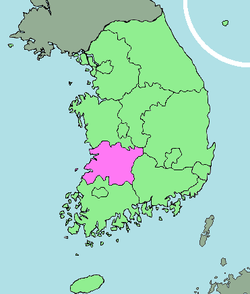- Jeollabuk-do
-
Jeollabuk Province
전라북도
Jeonbuk全羅北道
Jeollabuk-do
Emblem of Jeollabuk
Map of South Korea with Jeollabuk highlighted Government Province Capital Jeonju Governor Kim Wan-joo Dialect Jeolla Region Honam Area 8,051 km²(7th) Population (2005) - Population 1,784,013 (6th) - Density 221 /km² Cities 6 Counties 8 Website [1] (English) Metropolitan Symbols - Flower Zinnia - Tree Ginkgo - Bird Magpie Jeollabuk-do (North Jeolla) is a province in the southwest of South Korea. The province was formed in 1896 from the northern half of the former Jeolla province, and remained a province of Korea until the country's division in 1945, then became part of South Korea. The provincial capital is located at Jeonju, which was the capital of all of Jeolla before 1896.
Contents
History
During the Proto-Three Kingdoms period, Jeolla region was the center of the Mahan confederacy among Samhan. There were 15 tribal countries out of 54 located in the region. In the period of the Three States, this region came to belong to Baekje when it absorbed Mahan. Baekje was destroyed by the Silla and Chinese Tang dynasty allied force in 660 (20th year of King Uija) and ruled by Tang. It became a part of Silla when Tang was expelled in 676 (16th year of King Munmu).
When there were 9 states and 5 small capitals in Unified Silla in 685, there were Wansan-ju (present Jeonju) and Namwon-gyeong (present Namwon) in Jeollabuk-do, currently.
In 892, General Gyeon Hwon founded Hubaekje (Later Baekje), this area continued to exist and was the center of the country for about 50 years. In 936, during the rule of Singeom, it was attributed to Goryeo Dynasty. From 900 to the time that Hubaekje was attributed to Goryeo, Wansan-ju (present Jeonju) had been its capital and the country ruled the whole Jeolla-do region.
In 996 (14th year of King Sungjong), this region was named as the Gangnam province, and Korean government established the 4 states (Jeonju-Jeonju area, Yeongju-Gobu area, Sunju-Sunchang area and Maju-Okgu area) in North Jeolla region.
Gangnam-do (Jeonbuk) and Haenam-do (Jeonnam) was combined and titled as Jeolla-do in 1018 (9th year of King Hyeonjong's reign).
During the Joseon Dynasty, as the administrative districts of the whole nation was organized in Eight Provinces system in 1413 (13th year of King Taejong's reign), Jeolla-do took the charge of vast areas of 1-prefectures, 4-autonomous county , 4-protectorate, 12-country and 31-county covering present Jeollanam-do, Jeollabuk-do and Jeju-do.
In 1896 (33rd year of King Gojong's reign), the whole country was divided into 13 provinces. Jeolla-do was divided into Jeollanam-do and Jeollabuk-do. Jeollabuk-do consisted of 26 country.
In 1963, Geumsan-gun was incorporated into Chungnam and Wido-myeon of Jeonnam was incorporated into Jeonbuk. Jeongju-eup and Namwon-eup were raised to cities in 1981 and Gimje-eup was raised to a city in 1989. There were Wansan-gu and Deokjin-gu established in Jeonju-city in the same year.
Due to establishment of cities in the mixed type of city-farming area in 1995, Okgu, Jeungeup, Namwon. Gimje and Iksan-Guns were combined, Gimje and Iksan-guns werere merged and Gunsan, Jeonju, Namwon, Gimje and Iri cities were integrated. Through repeated reorganizations of administrative districts, now the region consists of the administrative districts of 6 cities and 8 county.
Geographical location of Jeollabuk-do
Jeollabuk-do is located in the west-southern part of Korea, bordered on the east-southern by Hadong-gun, Hamyang-gun, and Geochang-gun of Gyeongnam, and Gimcheon-si of Gyeongbuk, Bangyabong Peak of Sobaek Mountain (1,732m), Toggibong Peak (1,534m), Myeongseungbong Peak (1,586m), Baekwoonsan Mountain (1,279m), Namdeokyusan Mountain (1,508m), and Muyongsan Mountain (1,492m), on the south by Yeongwang-gun, Jangseong-gun, Damyang-gun, Gokseong-gun, and Gure-gun, on the north by Geumsan-gun, Nonsan-si, Buyeo -gun, and Seocheon-gun of Choongnam, and Yeongdong-gun of Choongbuk, and on the west by China over the Yellow Sea.
The total area of Jeollabuk-do is 8,061.41 square kilometres (3,112.53 sq mi), which accounts for 8.1% of the total area of South Korea.
Transportation and industry
In the 1960s the Honam highway (which has since been upgraded to the Honam Expressway) was built. This created an industrial belt, connecting the cities of Iri (now called Iksan) and Gunsan (a port city) with the provincial capital of Jeonju.
International Sisterhood relationship & partnership
- Sisterhood relationship
 Jiangsu, People's Republic of China (27 October 1994)
Jiangsu, People's Republic of China (27 October 1994) Washington, United States (17 May 1996)
Washington, United States (17 May 1996) New Jersey State,United States (19 May 2000)
New Jersey State,United States (19 May 2000)
- Partnership
 Kagoshima Prefecture, Japan (30 October 1989)
Kagoshima Prefecture, Japan (30 October 1989) Ishikawa Prefecture, Japan (10 September 2001)
Ishikawa Prefecture, Japan (10 September 2001) Shanghai, People's Republic of China (17 April 2003)
Shanghai, People's Republic of China (17 April 2003) Shandong, People's Republic of China (2 November 2006)
Shandong, People's Republic of China (2 November 2006)
Administrative divisions
Cities
Counties
- Buan County (부안군; 扶安郡)
- Gochang County (고창군; 高敞郡)
- Imsil County (임실군; 任實郡)
- Jangsu County (장수군; 長水郡)
- Jinan County (진안군; 鎭安郡)
- Muju County (무주군; 茂朱郡)
- Sunchang County (순창군; 淳昌郡)
- Wanju County (완주군; 完州郡)
See also
- List of Korea-related topics
- Jeonbuk FC
External links
North Jeolla 
Capital Cities Counties  Regions and administrative divisions of South Korea
Regions and administrative divisions of South KoreaRegions Provinces Special self-governing province Special city Metropolitan cities Proposed special autonomous city Categories:- Provinces of South Korea
- Jeollabuk-do
- Sisterhood relationship
Wikimedia Foundation. 2010.
